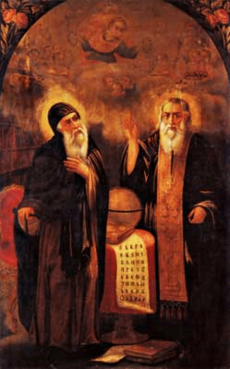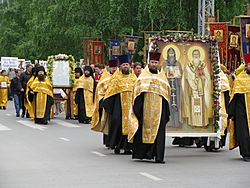Cyril and Methodius facts for kids
Quick facts for kids SaintsCyril and Methodius |
|
|---|---|
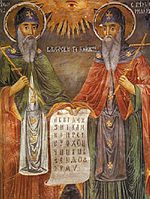
"Saints Cyril and Methodius holding the Cyrillic alphabet," a mural by Bulgarian iconographer Z. Zograf, 1848, Troyan Monastery
|
|
| Bishops and Confessors; Equals to the Apostles; Patrons of Europe; Apostles to the Slavs | |
| Born | 826 or 827 and 815 Thessalonica, Byzantine Empire (present-day Greece) |
| Died | 14 February 869 and 6 April 885 Rome and Velehrad, Great Moravia |
| Venerated in | Catholic Church Eastern Orthodox Church Anglican Communion Lutheranism |
| Feast | 11 and 24 May (Eastern Orthodox Church) 14 February (present Roman Catholic calendar); 5 July (Roman Catholic calendar 1880–1886); 7 July (Roman Catholic calendar 1887–1969) 5 July (Roman Catholic Czech Republic and Slovakia) |
| Attributes | Brothers depicted together; Eastern bishops holding up a church; Eastern bishops holding an icon of the Last Judgment. Often, Cyril is depicted wearing a monastic habit and Methodius vested as a bishop with omophorion. |
| Patronage | Bulgaria, North Macedonia, Czech Republic, Slovakia, Transnistria, Serbia, Archdiocese of Ljubljana, Europe, Slovak Eparchy of Toronto, Eparchy of Košice |
Saints Cyril (born Constantine, 826–869) and Methodius (815–885) were two brothers from the Byzantine Empire. They were important Christian thinkers and missionaries. They are known as the "Apostles to the Slavs" because of their work spreading Christianity among Slavic people.
They are famous for creating the Glagolitic alphabet. This was the first alphabet used to write Old Church Slavonic, an early Slavic language. After they died, their students continued their important missionary work. Both brothers are honored as saints in the Eastern Orthodox Church. In 1880, Pope Leo XIII added their feast day to the calendar of the Roman Catholic Church. Later, in 1980, Pope John Paul II declared them co-patron saints of Europe, along with Benedict of Nursia.
Contents
Who Were Cyril and Methodius?
Their Early Lives
The two brothers were born in Thessalonica, which is now in Greece. Cyril was born around 827–828, and Methodius around 815–820. Cyril was the youngest of seven brothers. His birth name was Constantine, but he took the name Cyril when he became a monk. Methodius was born Michael and became Methodius when he became a monk.
Their father, Leo, was an officer in the Byzantine army. Their mother's name was Maria. When Cyril was fourteen, their father died. A powerful minister named Theoktistos became their guardian. He helped them get a good education. Cyril later became a priest.
Mission to the Khazars
Around 860, the Byzantine Emperor Michael III and the Patriarch Photius sent Cyril on a mission. He went to the Khazars, a group of people who had asked for a scholar. They wanted someone who could talk with both Jews and Muslims. It's believed that Methodius might have gone with Cyril on this trip.
After returning to Constantinople, Cyril became a professor of philosophy. His brother Methodius had become an important leader in his monastery.
Their Mission to the Slavs
Working in Great Moravia
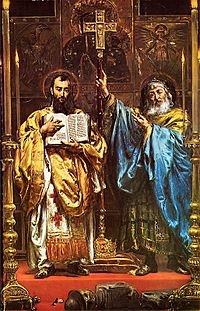
In 862, the brothers began their most important work. Prince Rastislav of Great Moravia asked the Emperor to send missionaries. He wanted them to teach Christianity to his Slavic people. Rastislav wanted to become more independent from the Frankish rulers.
The Emperor sent Cyril and Methodius. Their first job was to train helpers. In 863, they started translating important Christian texts. These included parts of the Gospels and other church books. They translated them into a language now called Old Church Slavonic. They then traveled to Great Moravia to share these translations.
They were very successful. However, they faced problems with German church leaders. These leaders did not want a Slavic language used in church services.
Creating the Glagolitic Alphabet
For their mission, Cyril and Methodius created the Glagolitic alphabet. This was the first alphabet made for Slavic languages. It was designed to fit the sounds of Slavic speech. The Cyrillic alphabet, which many languages still use today, developed from Glagolitic.
The brothers also wrote the first Slavic Civil Code. This set of laws was used in Great Moravia. The language they developed, Church Slavonic, is still used in church services by some Orthodox and Eastern Catholic churches.
It's not fully clear exactly what they translated first. The New Testament and the Psalms were likely among the first. They probably used the Roman alphabet as a guide for some of their translations.
Journey to Rome
Cyril and Methodius had great success because they used the people's own language. But in Great Moravia, they met missionaries from East Francia. These missionaries used Latin in their church services. They believed Moravia should only use Latin.
To avoid arguments, the brothers decided to travel to Rome to see the Pope. They wanted to find a peaceful solution. In 867, Pope Nicholas I invited them to Rome. The German bishops were upset because Cyril and Methodius were using Slavic.
The brothers arrived in Rome in 868. They brought with them holy objects, including the relics of Saint Clement. Pope Adrian II welcomed them warmly. The Pope saw that the brothers could help expand the Church's influence.
Pope Adrian II approved the use of the new Slavic language in church services. He made Methodius an Archbishop. The Pope himself ordained Methodius as a priest. Five of their Slavic students also became priests or deacons. These five students, along with Cyril and Methodius, are known as the "Seven Saints" in the Bulgarian Orthodox Church.
Cyril became a monk and took the name Cyril. He died in Rome fifty days later, on February 14, 869.
Methodius Continues Alone
After Cyril's death, Methodius continued their work alone. He returned to the Slavic lands. However, Prince Rastislav had been captured, and German rulers took control. Methodius was arrested by German bishops and held prisoner for two and a half years.
Pope John VIII (872-882) helped Methodius get released in 873. The Pope wanted Methodius to stop using the Slavic language in church services. Methodius was given back his authority over Great Moravia.
Methodius continued to use the Slavic language, despite the Pope's instruction. This caused more complaints against him in Rome. In 878, Methodius was called back to Rome. He was accused of teaching wrong ideas and using Slavic.
This time, Pope John VIII was convinced by Methodius' arguments. He sent Methodius back, clearing him of all charges. He also gave him permission to use the Slavic language. However, after Pope John's death, the situation changed. A new bishop, Witching, took over. He stopped the Slavic church services and forced Methodius' followers to leave Great Moravia.
Many of Methodius' students found safety in the First Bulgarian Empire. There, they were welcomed by Prince Boris the Baptizer. They helped set up important schools, like the Preslav Literary School and Ohrid Literary School. In these schools, they developed the Cyrillic alphabet based on Greek and Glagolitic letters. Cyrillic slowly replaced Glagolitic. It became the official alphabet of the Bulgarian Empire and spread to other Slavic lands. This helped Christianity spread throughout Eastern Europe.
Methodius was buried in the main church of Great Moravia. The exact location of his grave is still unknown today.
Creating the Glagolitic and Cyrillic Alphabets
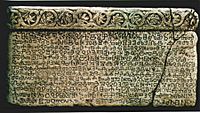
The Glagolitic and Cyrillic alphabets are the oldest known Slavic alphabets. The brothers or their students created them. They were used to translate the Gospels and church books into Slavic languages. The early Glagolitic alphabet was used in Great Moravia from 863 to 885. It was used for government and religious documents.
The Glagolitic alphabet is traditionally credited to Cyril. A papal letter from 880 confirmed that the alphabet was "invented by Constantine the Philosopher" (Cyril). This means that before Cyril, Slavic languages did not have their own unique writing system.
The early Cyrillic alphabet was developed in the First Bulgarian Empire. Students like Kliment and Naum helped improve it. They made it simpler and more like the Greek alphabet. This happened at the Preslav Literary School in the late 9th century.
After Cyril's death, Clement of Ohrid worked with Methodius. After Methodius died in 885, Clement continued the fight against the German clergy. He was jailed but then expelled from Great Moravia. He went to the Bulgarian Empire with Naum and others. Prince Boris I asked them to teach future clergy in the Slavonic language.
After Bulgaria adopted Christianity in 865, church services were in Greek. Prince Boris wanted to keep Bulgaria independent. So, he decided to use the Old Slavonic language. He set up two schools, in Pliska and Ohrid. Theology was taught there in Slavonic. Clement taught about 3,500 students in Slavonic and Glagolitic for seven years.
How Are They Remembered Today?
Saints Cyril and Methodius' Day
Cyril was seen as a saint soon after he died. His fame spread among the people he taught. The brothers are still highly respected by both Roman Catholic and Orthodox Christians. Their feast day is celebrated on February 14 in the Roman Catholic Church. In the Eastern Orthodox Church, it is on May 11 (or May 24 on the Gregorian calendar).
The celebration also honors the spread of literacy and the Christian message in the Slavonic language. In 1980, the brothers were declared "Patrons of Europe."
The first public celebration of Saints Cyril and Methodius' Day was in Plovdiv, Bulgaria, on May 11, 1851. It was called the "Day of the Bulgarian script."
This day is now a public holiday in several countries:
- In Bulgaria, it's on May 24. It's called the "Bulgarian Education and Culture, and Slavonic Script Day." It celebrates Bulgarian culture, literature, and the alphabet.
- In North Macedonia, it's also on May 24. It's known as the "Saints Cyril and Methodius, Slavonic Enlighteners' Day."
- In the Czech Republic and Slovakia, it's on July 5. It's a national holiday celebrating the "Slavic Missionaries Cyril and Methodius Day."
- In Russia, it's on May 24. It's called the "Slavonic Literature and Culture Day." It celebrates Slavic culture, literature, and the alphabet. It is not a public holiday in Russia.
Other Ways They Are Honored
Many places are named after Saints Cyril and Methodius.
- The national library of Bulgaria in Sofia is named after them.
- The Ss. Cyril and Methodius University of Skopje in North Macedonia bears their name.
- The St. Cyril and St. Methodius University of Veliko Tarnovo in Bulgaria is also named for them.
- In the United States, the SS. Cyril and Methodius Seminary in Orchard Lake Village, Michigan is named after them.
The Brotherhood of Saints Cyril and Methodius was a group formed in 1846. It aimed to protect Ukrainian identity in the Russian Empire.
Saints Cyril and Methodius are the main patron saints of the Archdiocese of Ljubljana in Slovenia. They are also patron saints of some Eastern Catholic churches in Slovakia and Canada.
Two peaks in the Tangra Mountains in Antarctica are named St. Cyril Peak and St. Methodius Peak.
Saint Cyril's remains are in a chapel inside the Basilica di San Clemente in Rome.
The Basilica of SS. Cyril and Methodius in Danville, Pennsylvania, is the only Roman Catholic basilica dedicated to them. It is the main chapel for a group of nuns called the Sisters of SS. Cyril and Methodius.
The Order of Saints Cyril and Methodius is a national award in Bulgaria, first created in 1909.
In 2021, a new research vessel for the Bulgarian Navy was named Ss. Cyril and Methodius.
Gallery
-
Basilica of St.Cyril and Methodius in Moravian Velehrad, Czech Republic
-
Inauguration of the monument to Saints Cyril and Methodius in Saratov on Slavonic Literature and Culture Day
-
Thessaloniki - monument of the two Saints gift from the Bulgarian Orthodox Church
-
Bulgaria - Statue of the two Saints in front of the SS. Cyril and Methodius National Library in Sofia
-
North Macedonia - The monument in Ohrid
-
North Macedonia - Statue of Cyril and Methodius near the Stone Bridge in Skopje
-
Czech Republic - Statue of Saints Cyril and Methodius at the Charles Bridge in Prague
-
Czech Republic - Saints Cyril and Methodius monument in Mikulčice
-
Czech Republic - Statue of Saint Methodius at the Holy Trinity Column in Olomouc in Moravia
-
Russia - the monument in Khanty-Mansiysk
-
Opening of Cyril and Methodius monument in Donetsk
Names in Other Languages
Here are the names of Cyril and Methodius in some other languages:
- Greek: Greek: Κύριλλος καὶ Μεθόδιος (Kýrillos kaí Methódios)
- Old Church Slavonic: Кѷриллъ и Меѳодїи
- Belarusian: Belarusian: Кірыла і Мяфодзій (Kiryła i Miafodzij)
- Bulgarian: Bulgarian: Кирил и Методий (Kiril i Metodiy)
- Croatian: Croatian: Ćiril i Metod
- Czech: Czech: Cyril a Metoděj
- Macedonian: Macedonian: Кирил и Методиј (Kiril i Metodij)
- New Church Slavonic: Кѷрі́ллъ и҆ Меѳо́дїй (Kỳrill" i Methodij)
- Polish: Polish: Cyryl i Metody
- Russian: Russian: Кири́лл и Мефодий (Kirill i Mefodij)
- Serbian: Serbian: Ћирило и Методије / Ćirilo i Metodije
- Slovak: Slovak: Cyril a Metod
- Slovenian: Slovene: Ciril in Metod
- Ukrainian: Ukrainian: Кирило і Мефодій (Kyrylo i Mefodij)
See also
 In Spanish: Cirilo y Metodio para niños
In Spanish: Cirilo y Metodio para niños
- Cyrillo-Methodian studies
- Brotherhood of Saints Cyril and Methodius
- Byzantine Empire
- Glagolitic alphabet
- SS. Cyril and Methodius Seminary
- SS. Cyril and Methodius University of Skopje
- SS. Cyril and Methodius National Library in Sofia
- St. Cyril and Methodius University of Veliko Tarnovo
- Saints Cyril and Methodius Faculty of Theology, Palacký University of Olomouc



